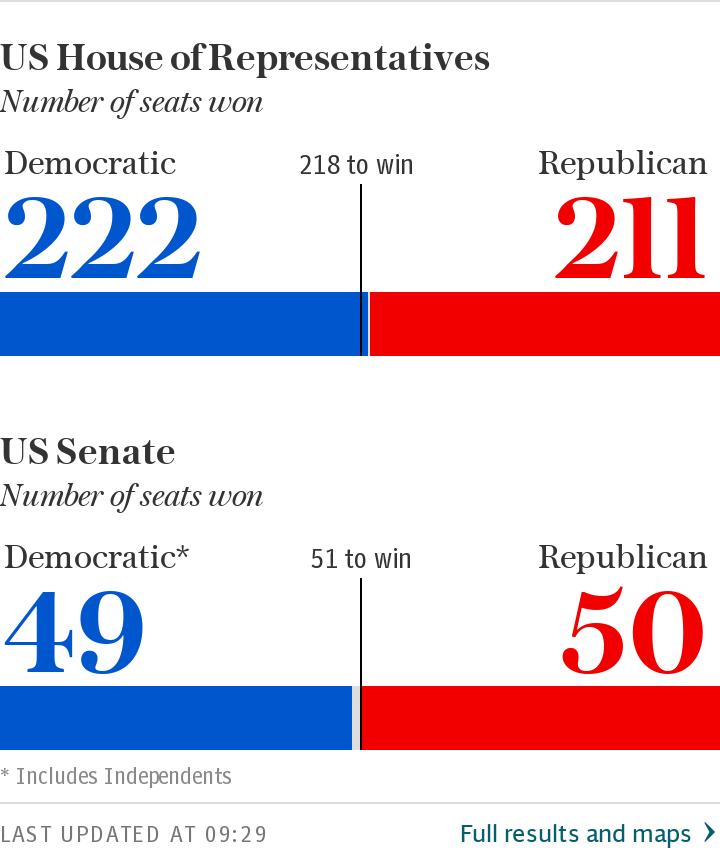US Senate election results 2020: What are the key races to watch, and why is it important?

All eyes are focused on the tight battle between Donald Trump and Joe Biden, as they continue to scramble for their place in the White House. However, another important race rages on.
In the early stages, the Republican party appeared to maintain control of the United States Senate as they won key races in Iowa, Alabama and South Carolina.
However, as of November 6th, the Republican control of the Senate is looking increasingly under threat, after the Democrats flipped two seats, in Colorado and Arizona, bringing both parties to 48 seats each- with 51 needed for a majority.
Georgia will prove to be crucial with one Senate race runoff on January 5 confirmed between Republican Senator Kelly Loeffler (26 per cent) and Democrat Raphael Warnock (32.9 per cent).
Both were unable to reach the 50 per cent threshold required to win the seat.
The Senate race in Georgia between Republican Senator David Perdue (49.8 per cent) and Democrat Jon Ossoff (47.8 per cent) now appears to be headed for a runoff on January 5 too.
To secure a majority, the Democrats need three seats -one of which they will take if Mr Biden wins the presidency, as the vice president has the power to cast the tie-breaking vote.
The battle for the United States Senate is also hugely significant for the future of the country.
But why is this the case? Read below to find out.
Follow live 2020 US election results here
When will we know the winner of the US election?

What is it?
The Senate is the upper chamber of Congress, which has the power to ratify treaties, confirm senior government appointees and judges, as well as introducing legislation. The lower chamber of Congress is the House of Representatives, which has 435 members.
Every four years when the presidency is up for grabs, one third of the 100-member Senate and the entire House are up for election. This also happens in even-numbered years when there is not a presidential election.
Senators serve six-year terms and must be at least 30 years of age.
Prior to the election, the Senate was under Republican control, with the party enjoying a 53-47 majority, but the impending results could change this.
The most up-to-date figures project that the Republicans and Democrats (including independents) have both won 48 seats so far. Fifty-one is needed for a Senate majority.
Why is it important?
The race between the Democrats and Republicans is tight this year - and the result could have great implications for whoever wins the presidency.
The party that controls the Senate will have power over the next president’s legislative agenda, cabinet officials and judicial appointments.
If Democratic nominee Joe Biden unseats Mr Trump, but fails to gain the Senate, he could be left unable to pass legislation important to his presidency - on issues such as healthcare, climate change and immigration.
Likewise for Mr Trump, a Democrat-controlled Senate could stall some of his more conservative policies.
Until now a gridlock in the Senate has had a significant impact, leading to little progress on key issues including economic recovery during the coronavirus pandemic.
Where will the battle be decided?
Eight of the top 10 seats viewed most likely to flip were held by Republicans. The party is defending 23 seats this year, compared to the Democrats’ 12.
So far, the Republicans have held onto a number of states considered competitive by Democrats - including North Carolina, Montana, and Iowa.
Republican Susan Collins has retained her Senate seat in Maine. The loss for Democrat Susan Gideon is a negative indicator on the Democrats' hopes to regain control of the Senate.
Under Maine’s ranked choice voting system, a candidate must have the majority of the vote to be declared the winner, otherwise second preferences are taken into consideration.
The Democrats managed to flip Arizona, with former astronaut Mark Kelly beating the incumbent Republican Martha McSally 52.5 per cent to 47.4 per cent.
Colorado also turned blue as Democrat John Hickenlooper won the senate vote by 53.9 per cent to 44 percent.
But the Democrats were not so successful in Alabama, as Republican Tommy Tuberville won the senate seat the Democrats had managed to capture during a special election in 2017.
The battle for the Senate may not be decided until January 5 with two runoffs in Georgia between Senator Kelly Loeffler (26 per cent) vs Democrat Raphael Warnock and Republican Senator David Perdue (49.8 per cent) vs Democrat Jon Ossoff (47.8 per cent) (32.9 per cent).
Both Republican and Democrat candidates have failed to reach the required 50 per cent threshold to win the seats.
Who are the key players?
In Maine, long-term Republican Senator Susan Collins has been caught between voters who are unhappy she has not embraced Mr Trump and those who are disappointed she has not done more to stand up to him, giving the Democrats an opportunity. Despite these divisions, Collins succeeded in retaining her seat.
Over in Colorado first-term Republican Senator Cory Gardner suffered from the decline in Mr Trump’s popularity, for whom he has been considered a long-term ally, giving Democrat John Hickenlooper the win.
Arizona’s Republican candidate too is suffering from her connection to Mr Trump. Martha McSally lost to former astronaut Mark Kelly, in part due to Mr Trump’s alienation to Arizona's growing suburban and Latino population.
In Michigan, Democrat Senator Gary Peters has a 49.8 per cent majority among the electorate, Republican John James' has 48.3 per cent giving Peters the win.
And in of Alabama Senator Democrat Doug Jones lost to Republican Tommy Tuberville.

Who looks likely to win?
So far the Senate race looks even closer than the presidential election. Democrats were favoured by forecasters to win the presidency and keep the House majority, but the future of the Senate is far less certain.
As both parties currently hold 48 seats each, it is now too close to call the results of the Senate. However, with the ever-impending results of the presidential election, and the vice president’s power over a tie-breaking vote, we are projected to have a likely winner very shortly.
With more than 98 per cent of results currently announced in Georgia, Mr Biden is narrowly poised to win the state and will be the first Democrat to do so since Clinton in 1992.
But what would a Biden victory in Georgia mean for the Senate?
A blue Georgia would make it likely that the state would have to hold two runoffs for its seats in the Senate in January, and Republicans power in the chamber is possibly under threat.
Recent results from this morning, November 6th, saw the Georgian county of Clayton narrowed the lead of Republican Senator David Perdue, over the Democratic opposition Jon Ossoff. Senator Perdue claimed 49.8 per cent of the vote, meaning he was 0.2 per cent short of the 50 per cent essential to win the race. Meanwhile, on the morning of November 6th, the Democrats gained another single in the Senate, leading to the current 48-to-48 seat tie.
The Republicans looked likely to win a majority as they held on to key states such as Iowa, Montana and South Carolina. They had also managed to win back the Senate seat in Alabama from the Democrats.
The Democrats have managed to flip senate seats in Colorado and Arizona, though, they still currently fall short of the 51 seats needed to win a majority.
The appointment of Amy Coney Barrett as Supreme Court judge could also have an impact yet to be reflected by analysis.
What are the key races to watch?
As the struggle for the Senate is so unpredictably narrow, there are several vital races which might just swing the outcome of the 2020 Senate election.
Firstly, California’s 21st Congressional District is an important race, as Democrat, TJ Cox’s ability to maintain his seat in the previously Republican-ruled area of Southern California will offer an indication of the strength of the blue’s power overall. Just two years ago, in 2018, Cox defeated the Republican candidate, David Valadao, by less than one point, so the world will undoubtedly watch this re-battle in anticipation.
The race for New York’s 11th Congressional District is another telling sign of Mr Trump or Mr Biden’s success, as, despite New York’s reputation as a Democratic state, Republican Nicole Malliotakis is putting up a tough fight for this Staten Island borough with a previously Republican stronghold.
The battle between Xochitl Torres Small, a Democratic Congresswoman, and Republican Yvette Herrell, for the 2nd Congressional District of New Mexico, was one to watch and turned out to be an exceptionally close race. The Democrats claimed the district by as little as 4,000 votes in 2018. In Republican Herrell claimed this win.
What time do the results come out?
Results in the neck-and-neck race are expected to be announced on Friday, November 6, at the earliest.
Mitch McConnell, the Senate majority leader, has been re-elected, according to AP. Polls suggest Mr McConnell has seen off the challenge of Democrat Amy McGrath.
But it remains to be seen what kind of job Mr Connell will be going back to in January if the Democrats flip the Senate.

2020 Senate Polls:
While the presidential race consumes most of the news throughout the 2020 election, it is essential to remember that around a third of the 100-member Senate is up for re-election. Gaining a majority of the Senate would be a massive victory for the Democrats, as the Republicans overrule the Senate by 53-47. This would give the Democrats the overwhelming power to approve specific trade deals and legislation's, while also having the capacity to promote certain individuals to governmental positions.
Among the key states with the power to swing the control over the Senate are Washington, which is split 53-47 between Republicans and Democrats, and North Carolina, whose race for the Congress is one of the most expensive congressional battles in US history.
US Senate Election Predictions:
In earlier polls, the Democrats appeared to be coming out slightly on top, though, absolutely nothing is certain.
It is vital to note that while exit polls may give an indication to who will come out victorious, nothing is certain until the electoral college confirm the numbers.

